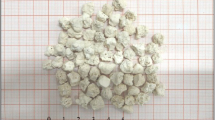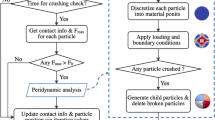Abstract
Since the pioneering work of Griffith, Linear Elastic Fracture Mechanics has been widely experimentally validated and successfully developed in solid mechanics modeling. However, recent theoretical models applying the energy balance found in Griffith theory specifically for quasi-static confined comminution have until now not been systematically confronted to experiments. In this study, we analyze data of compression tests on crushable sand, where grain breakage has been triggered by flooding the initially dry material at constant stresses. We consider a partition of the dissipation between surface fracture energy and the rearrangement of fragments and grains surrounding crushed particles. Our results show that the role of the surface fracture energy is stressdependent and that its influence becomes less significant at high stresses.
Similar content being viewed by others
References
ASTM C204-11 (2011). Standard Test Methods for Fineness of Hydraulic Cement by Air-Permeability Apparatus, Annual Book of Standards Vol. 04.01
Ashby, M., Jones, D. (2006). Engineering Materials 1. 3rd edition, Elsevier. Oxford. 424 p.
Åström J.A., Herrmann H.J. (1998) Fragmentation of grains in a two dimensional packing, Eur. Phys. J. B 5: 551–554
Atkinson , B. K. (1982) Subcritical crack growth in geological materials. J. Geophys. Res. 89(B6): 4077–4114
Biarez J., Hicher P.Y. (1997) Influence de la granulométrie et de son évolution par ruptures de grains sur le comportement mécanique de matériaux granulaires. Revue Françse de Génie Civil 1(4): 607–631
Cundall P., Strack O. (1979) A discrete numerical model for granular assemblies, Géotechnique 29(1): 47–65
Daouadji A., Hicher P-Y. (2010) An enhanced constitutive model for crushable granular materials. Int. J. Numer. Anal. Meth. Geomech. 34(6): 555–580
Daouadji A., Hicher P-Y., Rahma A. (2001) An elastoplastic model for granular materials taking into account grain breakage. Eur. J. Mech. A-Solid. 20: 113–137
Einav I. (2007) Breakage mechanics- Part I: Theory. J. Mech. Phys. Solids 55(6): 1274–1297
Grady D. E. (1982) Local Inertial Effects in Dynamic Fragmentation”. Journal of Applied Physics 53: 322–325
Griffith A.A. (1921) The phenomena of rupture and flow in solids. Phil. Trans. R. Soc. Lond. A 221: 163–198
Hu W., Yin Z., Dano C., Hicher P.-Y. (2011) A constitutive model for granular materials considering grain breakage. Sci. China Tech. Sci. 54: 1–9
Jandacka P., Hlavac L., Madr V., Sancer J., Stanek F. (2009) Measurement of specific fracture energy and surface tension of brittle materials in powder form. Int. J. Fract. 159: 103–110
Lee I., Coop M. (1995) The intrinsic behaviour of a decomposed granite soil. Géotechnique 45(1): 117–130
McDowell G. R., Amon A. (2000) The application of Weibull statistics to the fracture of soil particles. Soils Found. 40(5): 133–141
McDowell G. R., Bolton M. D., Roberston D. (1996) The fractal crushing of granular materials. J. Mech. Phys. Solids 44(12): 2079–2102
Muir Wood, D., Kikumoto, M., Russell, A.R. (2009). Particle crushing and deformation behaviour. Prediction and simulation methods for geohazard mitigation (eds F. Oka, A. Murakami, S. Kimoto), CRC Press, London.
Miura N., O-Hara S. (1979) Particle-crushing of a decomposed granite soil under shear stresses. Soils Found. 19(3): l–14
Nguyen G., Einav I. (2009) The energetics of cataclasis based on breakage mechanics. Pure Appl. Geophys. 166: 1693–1724
Nieto-Gamboa, C. (2011). Mechanical behavior of rockfill materials application to concrete face rockfill dams. Doctoral Thesis, Ecole Centrale Paris, France
Oldecop L., Alonso E. (2001) A model for rockfill compressibility. Geotechnique 51(2): 127–139
Oldecop L., Alonso E. (2007) Theoretical investigation of the time dependent behavior of rockfill, Géotechnique 57(3): 289–301
Ovalle, C., Frossard, E., Dano, C., Hu, W., Maiolino. S., Hicher, P-.Y (2013). The effect of size on the strength of coarse rock aggregates and large rockfill samples through experimental data, submitted to Acta Mechanica
Pugno N. (2006) Dynamic Quantized Fracture Mechanics. Int. J. of Fracture 140: 159–168
Pugno N., Carpinteri A. (2008) On linear elastic fragmentation mechanics under hydrostatic compression. Int. J. Fract. 149: 113–117
Roscoe K., Schofield A., Thurairajah A. (1963) Yield of clays in states wetter than critical. Géotechnique 13(3): 211–240
Russell A. (2011) A compression line for soils with evolving particle and pore size distributions due to particle crushing. Géotechnique Letters 1: 5–9
Russell A., Khalili N. (2004) A bounding surface plasticity model for sands exhibiting particle crushing. Can. Geotech. J. 41(6): 1179–1192
Tsoungui O., Vallet D., Charmet J.C. (1999) Numerical model of crushing of grains inside two-dimensional granular materials. Powder Technol. 105: 190–198
Author information
Authors and Affiliations
Corresponding author
Rights and permissions
About this article
Cite this article
Ovalle, C., Dano, C. & Hicher, PY. Experimental Data Highlighting the Role of Surface Fracture Energy in Quasi-Static Confined Comminution. Int J Fract 182, 123–130 (2013). https://doi.org/10.1007/s10704-013-9833-4
Published:
Issue Date:
DOI: https://doi.org/10.1007/s10704-013-9833-4




